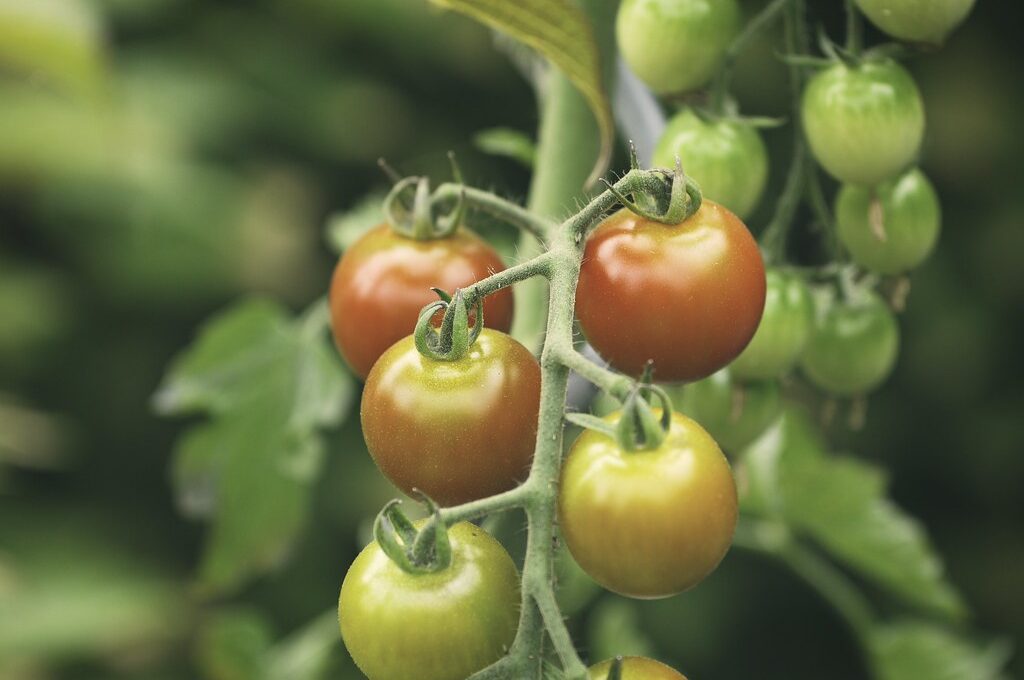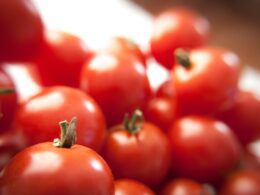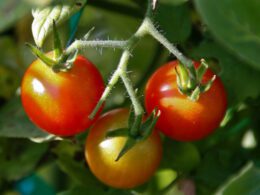Are you wondering if it’s a good idea to let your tomato plants dry out between watering sessions? You’re not alone. Many gardeners ask themselves this question, as they want to ensure the health and safety of their precious tomato plants.
In this article, we’ll dive into the advantages and drawbacks of allowing the soil to dry out between watering, as well as provide tips for striking the right balance for optimal growth.
Before you grab that watering can again, take a moment to consider how much moisture is really needed for your tomatoes. Overwatering can be just as harmful as underwatering – both can lead to issues like root rot or stunted growth.
Read on to learn more about understanding your tomato plant’s water requirements and keeping them safe and healthy throughout their growing season.
Understanding Tomato Plant Water Requirements
It’s essential to grasp your tomato plants’ water needs for a healthy and fruitful garden. Knowing when and how much to water can make a significant difference in the quantity and quality of your harvest.
Tomato plants typically need about 1-2 inches of water per week, but this amount can vary depending on factors like soil type, climate, and plant size. To strike the right balance between overwatering and underwatering, keep an eye on your tomato plants’ overall health.
Signs of dehydration include wilting leaves, slow growth, or fruit cracking. Overwatered plants may also wilt but can develop yellowing leaves, root rot, or blight diseases. To avoid these issues, it’s best to keep the soil consistently moist without letting it become soggy.
A good practice is to let the top inch or so of soil dry out between watering sessions – this helps prevent overwatering while still providing enough moisture for healthy growth. Keep in mind that more frequent watering may be necessary during hot summer days or if you’re growing tomatoes in containers with limited soil volume.
By staying attentive to your tomato plants’ needs and adjusting your watering schedule accordingly, you’ll create a thriving garden with plenty of delicious tomatoes to enjoy!
Advantages of Letting Soil Dry Out Between Watering
By allowing the soil to dry out between waterings, you’re encouraging strong root growth and preventing common problems like overwatering. Tomato plants benefit from a deeper, more robust root system that can efficiently access water and nutrients. When the soil dries out slightly, roots are encouraged to grow deeper in search of moisture, resulting in a healthier plant overall.
Additionally, by not keeping the soil constantly moist, you reduce the risk of diseases and pests that thrive in damp environments. Letting the soil dry between watering also helps you avoid issues such as root rot and mold growth. Overwatering creates an environment where harmful pathogens can multiply rapidly, putting your tomato plants at risk for disease or even death.
By giving your plants a chance to breathe between waterings and ensuring proper drainage in your garden beds or containers, you’ll promote a safer growing space for your tomatoes. When it comes time to water again after letting the soil dry out, be sure to provide a deep watering that reaches down into the lower layers of soil where those stronger roots have developed. This will help maintain consistent moisture levels throughout the entire depth of your garden bed or container while still promoting healthy root growth.
Remember – moderation is key when it comes to maintaining optimal health for both tomato plants and their caretakers alike!
Drawbacks and Risks of Allowing Soil to Dry Out
While there are benefits to letting soil dry out between waterings, it’s also important to consider the potential drawbacks and risks involved.
Allowing the soil to become too dry can lead to several issues that may negatively impact your tomato plants’ growth and health.
-
Under-watering: If you let the soil stay dry for too long, your tomato plants might not receive enough water, causing them to wilt or show signs of stress. This can reduce their overall productivity and even cause irreversible damage.
-
Inconsistent watering schedule: Tomatoes thrive best with consistent moisture levels in their soil. Allowing the soil to dry out completely between waterings may create fluctuations in moisture content that could stress your plants and affect their growth.
-
Encouragement of root pests: Dry soils may encourage certain pests like root nematodes and spider mites that cause damage by feeding on plant roots or leaves.
To strike a balance between keeping your tomatoes well-hydrated while allowing the soil to partially dry out, pay close attention to your plants’ needs.
Monitor the moisture level of the soil daily by sticking a finger about an inch into it – if it feels cool and damp, you can wait another day before watering; if it feels warm or very dry, give them a good soak.
By doing this simple check regularly, you’ll be able to provide your tomatoes with an optimal environment for healthy growth while minimizing any risks associated with overly-dry conditions.
Does Watering Methods Affect Tomato Growth in Pots vs. Ground?
Watering methods play a crucial role in the growth of tomatoes in pots or ground. Pots require careful watering to maintain optimal moisture levels without causing overwatering or underwatering. In contrast, ground-grown tomatoes benefit from deeper watering, allowing the roots to access water from the soil. Strategic watering techniques are essential to nurture healthy tomato plants, regardless of their growing medium.
Balancing Moisture Levels for Optimal Growth
To find the sweet spot for moisture levels in your tomato plants’ soil, keep a watchful eye on their needs and adjust watering accordingly.
Observe signs of overwatering or underwatering, such as yellow leaves or wilting. You can also check the soil’s moisture by sticking your finger about an inch into the dirt – if it feels dry, it’s time to water; if it’s still damp, hold off for another day.
One helpful tip to maintain balanced moisture levels is using mulch around your tomato plants. Mulching helps retain soil moisture, prevents weeds from competing for water, and keeps the roots cool during hot summer days.
Choose organic mulches like straw, wood chips, or grass clippings that break down over time and enrich the soil with nutrients. Consistent monitoring and adjusting will lead to optimal growth for your tomato plants while ensuring their safety from potential risks of too much or too little water.
By finding this balance in maintaining appropriate moisture levels, you’ll be able to grow healthy tomatoes that are both delicious and safe to eat! So go ahead and enjoy growing those juicy red fruits, knowing you’ve taken all necessary precautions for a successful harvest.
Will Using Sugar Water Help Prevent Tomatoes from Drying Out Between Watering?
Using sugar water for plants may actually do more harm than good when it comes to preventing tomatoes from drying out between waterings. Sugar can attract pests and promote fungal growth, potentially causing more damage to the tomatoes. It’s best to stick to regular watering practices to keep your plants healthy.
Tips for Proper Tomato Plant Watering
It’s crucial to master proper watering techniques for tomato plants, as this can make all the difference in achieving a bountiful harvest. You want to keep your plants evenly moist without allowing them to dry out too much between watering sessions. This means you’ll need to be attentive and monitor your plants’ needs, adjusting your watering schedule depending on factors like weather and soil type.
One helpful tip is to water deeply but less frequently, which encourages strong root growth by forcing the roots to reach deeper into the soil for moisture. Aim for at least one inch of water per week, either through rainfall or supplemental watering.
Remember to water at the base of the plant rather than from overhead, as wet leaves can lead to disease problems.
Another key aspect of proper tomato plant watering is consistency – maintaining a steady moisture level will help prevent issues such as blossom end rot and cracking fruit. Use mulch around the base of your plants to help retain moisture and regulate soil temperature throughout the season.
By following these simple guidelines, you can ensure that your tomato plants receive optimal hydration and grow healthy, delicious fruits for you and your family’s enjoyment!
Conclusion
So, should you let your tomatoes dry out between watering? The answer isn’t straightforward.
It’s crucial to strike a balance between keeping the soil moist and letting it dry out a bit. Remember to monitor your tomato plants’ water requirements and adjust as needed.
Follow proper watering tips for optimal growth, and you’ll be on your way to enjoying delicious homegrown tomatoes in no time!









